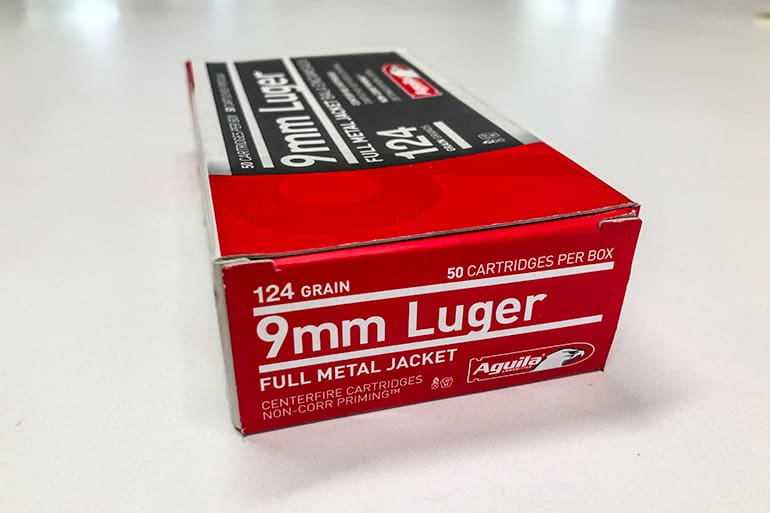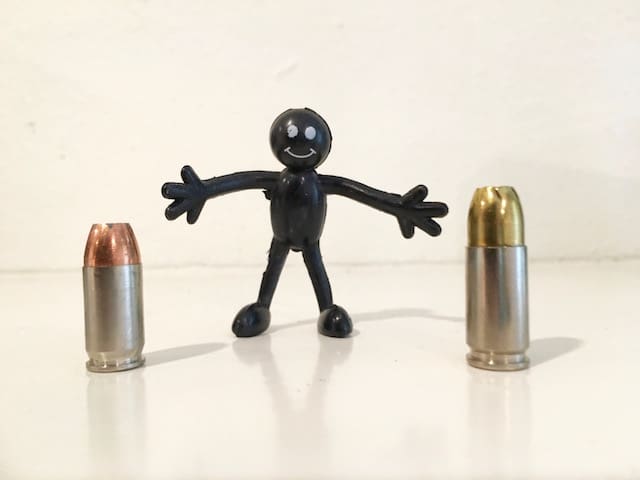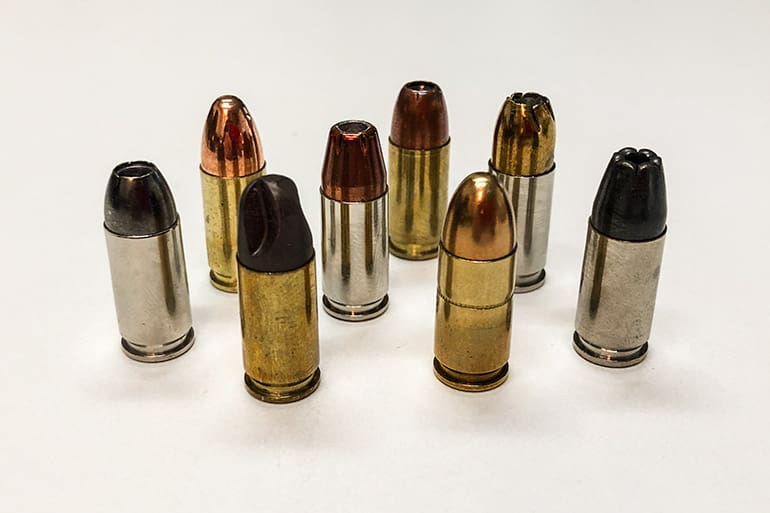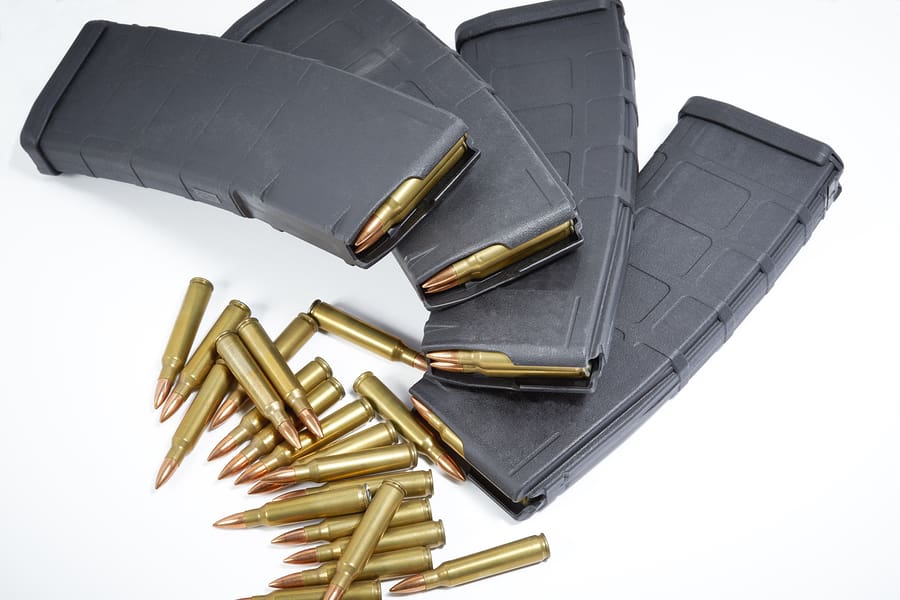The difference between 9mm and 9mm Luger ammunition is either nothing or the latter is part of the former. Depending on how you define it.
Huh?
Most of the time, when a person says “9mm” when talking about ammunition, they mean 9x19mm, which is the most commonly used handgun round. This is what you feed your GLOCK 19, your S&W M&P, your SIG P365 or — if you actually have taste in handguns (kidding!) — your 9mm 1911, Browning Hi Power, or CZ-75.
However, there is an entire family of handgun cartridges that uses the same size (9mm) projectile.
Why do people get them confused? Mostly it’s because of colloquial usage, as we here in the USA like our brevity. But it’s also because we don’t like the metric system and it’s infernal witchery.

But I digress. To get it out of the way, the 9x19mm round itself is the 9mm Luger round. It’s also known as 9mm Parabellum and 9mm NATO. It’s all the same bullet and cartridge used in semi-automatic handguns (mostly).
The round itself was developed by Georg Luger during the design process of his famous pistol, often referred to simply as a “Luger.” The comment section will probably hate me for skipping a lot of details, but I will just have to find a way to live with myself.

Initially, the pistol was chambered for a 7.65x21mm bullet, which Luger developed from the 7.65x25mm Borchardt cartridge…which also was the basis for the 7.63mm Mauser and 7.63mm Tokarev rounds. However, the German military felt that a larger round was probably a good idea, so he trimmed the case and inserted a 9mm (0.355-in) projectile.
Since the name of Luger’s pistol was actually the Pistole Parabellum (basically “pistol of war”) he therefore dubbed the two rounds 7.65mm Parabellum and 9mm Parabellum, respectively. However, the authorities of SAAMI and CIP being what they are, decided to call them .30 Luger and 9mm Luger (respectively) instead.
Further compounding the confusion, NATO decided to make it their standard pistol round. NATO has their own handloading manual and created a standard load for it. The standard 9mm NATO round is a 124-grain FMJ, loaded to 36,500 psi, which is a bit hotter than the CIP standard of about 34,000 psi. (SAAMI standards are 35,000 psi.) Thus, 9mm NATO is an overpressure variant.
A 124-grain 9mm NATO round zips along at about 1200 fps and just shy of 400 ft-lbs of energy. The standard pressure 124-gr loading of 9mm is usually slower by about 100 fps (depending) and carries about 50 fewer ft-lbs of energy out of the muzzle.

So, that’s the difference. 9mm Parabellum, 9x19mm Parabellum and 9mm Luger are all the same cartridge; 9mm NATO is just a specific loading of the round that’s approved by NATO for NATO use.
But I keep hearing about 9mm Browning and 9mm Makarov. What are those, you ask?
Let the hair-splitting begin!
Okay, so the 9mm Parabellum is just part of a family of handgun rounds that chamber the same 0.355-in (that’s 9 millimeters) projectile. There are a number of them, though only a few are popular in the United States.
It’s kind of like when people talk about 7mm rifles. Usually, when someone talks about “7mm” they typically mean 7mm Remington Magnum, 7mm-08 Remington or possibly 7x57mm Mauser as those are the most popular rounds with a 7mm-diameter projectile.
However, there are plenty of rounds that use the same size bullet, such as 7mm Remington Ultra, 7mm Weatherby Magnum, 7mm Shooting Times Westerner, Warren Page’s favorite wildcat the 7mm Mashburn Super Magnum, .280 Remington, .284 Winchester and .280 Ackley Improved…and more.

The most popular member of the 9mm family outside of 9mm Luger is .380 ACP, also called .380 Auto. Invented by John Browning, it uses the same size bullet as 9mm Parabellum, but in a much shorter case. The Europeans don’t know what a Quarter Pounder or a .380 is, so they refer to it by its metric diameter of 9 millimeters. As a result, it’s called 9mm Short, 9mm Kurz (German for “short”), 9mm Browning and 9x17mm, though not 9mm with cheese.
A similar round developed in Spain around the same time as the 9mm Parabellum was the 9mm Largo. 9mm Largo, or 9x23mm, employs a longer case than the 9mm Parabellum (23mm vs 19mm) and an ever-so-slightly lesser powder charge. Basically, knock 50 fps off a 9mm Luger and you got it.
While not common in the US at all, 9mm Largo (Spanish for “long,” should you ask) is popular in some Latin American countries.
Another variant, which found some adoption among European police agencies, was the 9x18mm Ultra. The 9x18mm Ultra uses a slightly longer case than the .380 ACP — 18mm vs 17mm — and nets about 20 fps and 60+ ft-lbs more. You won’t find it anywhere, though you might find the odd SIG P230 or P232 chambered for it.

The 9mm Makarov, or 9x18mm Makarov, however, is different. 9mm Makarov employs a .365-in diameter projectile, so it’s technically 9.27mm Makarov. However, the most important thing you should know about that minor detail is that nobody really cares.
Another variant is 9x21mm, also called 9mm IMI. This round was developed by Israel Military Industries for use in countries where civilians are forbidden to purchase firearms chambered in “military calibers.” 9x21mm IMI is basically the same as 9mm Parabellum. IMI, being some clever folks, seated the bullet deeper in the case so it’s the same overall length as 9mm Parabellum.
The competitive shooting world has also given us 9x25mm Dillon and 9x23mm Winchester. The former round is a 10mm case necked down for a 9mm projectile (sort of like .357 SIG) and the latter is (in broad strokes) a rimless .38 Super. These cartridges meet the Major power factor of IPSC and other competitive shooting events but haven’t caught on outside of that.
Dr. Brad Miller of Shooting Times and Handguns Magazine even proposed a new variant he called 9mm Auto. The 9mm Auto is a duplicate of the 9mm Parabellum ballistically, but revises the case to straight walls.
The 9mm Luger round actually has a slight taper (it narrows by about 0.01 inches from the base to the case mouth) which causes an exaggerated nosedive gap (the space between cartridges in a magazine) and thus causes the round to hit the pistol’s feed ramp at a rather low angle. This has been known to cause feeding problems in single-stack magazines. The 9mm Auto aims to correct this problem.
So…to sum up: 9mm is actually a family of cartridges, but we most often use it as shorthand to refer to the 9mm Luger, which is the most popular member of that family. Got it? Good.





And none of the above mentioned can be found in local stores. I did get lucky yesterday and brought home 200 rounds of 9mm from a pawn shop. Someone pawned a gun and the ammo. I am still searching for the
.9mm the media keeps referencing.
That’d be about the size of a sewing needle. Maybe use it in one of those science fiction Flechette guns with the ultra rapid fire (in the xK rounds per minute range) that literally filets a target.
Those would have an external means of propulsion as it would be too small to be self contained. Figure maybe a hand held rail gun or air gun.
Get the rpm up high enough with a 100′ range and you’ve got a very nice killing machine that would be as silent as the means used to propel the projectile.
A few reliable online retailers have 9mm ammo at decent prices, mainly bulk target ammo. I considered ordering some but I didn’t, I think I have enough. It made me realize that if I want more 9mm what I need is actually more rifle ammo, because if you have to shoot thousands of 9mm in the near future, you probably needed a different tool for the job.
It’s bad. I’m seriously thinking of buying a .40 now just so I can have another ammo option, and I thought I was done with .40 twenty year ago.
It’s actually easier to find .44 special for my Bulldog now than 9mm.
I have a Just Right Carbine PCC chambered in 9mm. The JRC is a multi caliber system, just swap out the bolt carrier, mag well and barrel (maybe 7 or 8 minute process) and you’re good to go with another caliber. I just did the conversion to .45 ACP ($220.00) and plan on getting the 40 S&W conversion kit next month. That should cover me for the most part if one or another caliber gets hard to find. I’ll Duracoat/Cerakote the barrel, mags and mag wells different colors ( black, OD Green,, FDE) to make it easy to identify the current configuration. Other calibers available are 357SIG and 10mm. So much cheaper than having to buy 3 complete rifles.
My local academy has 9mm makarov when we are not in pandemic mode.
I guess I’m sorta edumacated after 9 years. Didn’t learn anything new…oh and my longtime friend’s advice ” don’t get a gun that uses a boutique round” rings true. Good article except for the cutesy language😏
No, no, some of us like the “cutsey” language and pictures 🙂 Tho, I would call it clever, not cute. It kept me reading. All those numbers were too much like math class,(I did not do well) but I liked learning these numbers better than a x b x c – d = x. This is an article that I”m going to print. I know I need to read it again. Thanks Dan.
Boutique round? cute. First time I’ve heard that expression. I usually say something dumb like wildcat round. Althought that would be similar but not the same as a boutique round. Anyway I get the point.
All I know is that I have a lot of 9mm “something or the other” in ammo cans. If the mob ever comes for my house and I pull a “McCloskey” by standing on my front steps with my handgun at the ready, I’ll now be able to befuddle my potential assailants with an overload of 9mm tactical knowledge that will cause them to pause, reflect, and walk away in complete confusion over what any of it really means.
Well I now know from the vast array of firefights you’ve been in that you’ll expertly hit every aggressor with extreme precision under pressure and do so flawlessly.
Seriously you are one of the biggest dumbasses around this dump.
You’re the expert on dumb assery. You being His Supreme Majesty Dumb Ass the First.
Hey, good morning!
(in my best ‘Buddy the Elf’ voice) You seem like an angry elf today. Want a hug? 🙂
@ I haz is a a Blathering retard
No, he isn’t. And, YOU need a sense of humor.
Hhhmmm
Generator vs. Alternator
Fixed magnet DC operation versus AC rectified to DC.
🙂
Yes, Virginia, there is a difference.
The age old 9 versus 45,in todays world it either and or.
45? You mean the 11.43x23mm?
https://en.wikipedia.org/wiki/.45_ACP
Good to read something that was thorough. As I was reading I was sure I was going to be commenting ‘you forgot’ ___. Well done.
Left out the 9mm Federal
And the 9mm Glisenti. Dimensionally identical to 9mm Parabellum but with a much reduced charge. Used in an Italian service pistol through both world wars. And mistakes with ammunition did occur.
Reportedly dropped after they realized that it could be inadvertently fired in older .38S&W revolvers not designed to take the higher pressure.
This is true….but sad.
A 9mm Federal LCR would full ejection and a very compact speedloader.
“9mm Makarov employs a .365-in diameter projectile, so it’s technically 9.27mm Makarov. However, the most important thing you should know about that minor detail is that nobody really cares.”
I would imagine that if you’re buying bullets for reloading, then you should care.
Only 9 mm bullets you’ll find for reloading will likely be .355.
Hornady sells Mak bullets for reloading. Some commercial bullet casters also offer them.
“Unless you actually have taste in handguns.” 9mm 1911? Dumb idea and I love a 1911. Browning Hi-Power and CZ 75? Absolutely. Add H&K P7M8 and Sig P210 to that list. Now you’re done.
lh9cn
?
My very favorite #1 handgun in my entire collection is a super reliable compact 1911 chambered in 9mm. My EDCs and home guns are all Glocks now, so this 1911 has become my “safe queen” that gets the velvet glove treatment. Heirloom aspirations for the grandkids one day…
I have all three. Of the three, the 9mm 1911 is the clear winner in ergonomics, trigger, and accuracy
Gadsden:
“9mm 1911? Dumb idea”
Yup! I had one once. Looked all over for it. When I finally got it, I didn’t like it. Dumped it for something else.
A 9mm 1911 Combat Commander. Had one, didnt like it, sold it to get a Browning HP… Still have my .45acp Combat Commander, the “Almost Perfect Pistol” (along with a couple others)… Amazing how those old JMB designed firearms are still pluggin along in active use, a century (+ or -) after they were designed…
I think the caption has it backwards on that pic of the .380 vs. 9 mm (with the stick figure).
Blammo, I think it’s correct. Look at the case length.
I’m pretty sure it was corrected.
The .380 is on the left in the photo, the 9mm is on the right in the photo. No idea why the stick figure is even there.
As a frame of reference ……. for your stick figure.
Ok, I keep a spreadsheet on my ammo inventory and generally keep it up to date. Failure to evaluate my 9mm usage for range time. Suddenly found myself with only 1,900 rounds in inventory. No more 9mm range shooting until I can get it back up to 5,000 rounds. Given availability that is going to take awhile. Can’t believe it as I swore I would not get into a situation like this after the Hillary ammo crash. Everything else I can last for several years.
Maybe you can pick some up on the run. Your truck might run out of gas, then you are going to have to carry whatever ammo you can. Leave the rest behind for somebody else? Range shooting is fine, practice, check sights and function. Expending ammo for fun regularly is not a good idea. 7-10 rounds and that’s it, if all is good. Maybe every 3-6 months. (That’s just me). Maybe the spread sheet is a hobby?
I have half my 30 cal ammo cans loosely filled with one caliber, i.e 1000 rds 9mm in a can. The 50 cal cans are filled with a variety of calibers, for a quick grab and go. These ones are half filled with boxes of 9mm, half a brick of 22LR, several boxes of 5.56 and a few of boxes of 308 win.
“The 50 cal cans are filled with a variety of calibers, for a quick grab and go.”
That’s a damn good idea, thanks!
My .50 cal cans of 1,000 rounds of 9mm is on the heavy side anyways, and your idea of splitting it up means you should have at least a few rounds of every caliber you own if you have to grab-n-go in a hurry, and the same applies if another family member needs to do the same.
Ideas like that are why I love reading the comment section of TTAG… 🙂
Good reading. Cleared some of my confusion. (Lots more to be done, there!).
Thank you.
Now to add to your confusion. .38 special and .357 magnum are also 9mm. 🙂
I would not recommend reloading 9mm luger cases with .357 diameter bullets.
Kinda….but not really.
All are mid-bore….not exactly the same caliber.
And he didnt mention the 38 Super +P, which is a .356 like the 9×23 Win.
@Specialist38
better check that reloading manual
the .38 Super (or properly the Super .38 Colt) throws a 0.355″ projectile
the case is 22.84″ long
the neck diameter is 0.384″
the base diameter is 0.384″
the rim diameter is 0.406″
OAL is 1.280″
basically it’s the old .38ACP John Browning designed, loaded to its original specs.
same dimensions, but it was downloaded for the 1900 Colt.
.38 special. 9x29r. If memory serves.
WHAT? Details please?
0.3543307086614173 inches = 9mm
What’s next?
“The 9mm Luger round actually has a slight taper (it narrows by about 0.01 inches from the base to the case mouth)“
Yep, the round head spaces on this taper so it’s very important.
The first round I started reloading was 9 mm back in 1978 for my S&W 59.
Getting the taper right was accomplished by proper depth of the die seating in the press.
.38/.357 is so much easier.
But I’ve pretty much given up reloading now, with inexpensive ammo on the market my time is worth more then what I save by reloading but I don’t have the risk of hazardous material storage.
Why do you care? You want all guns banned anyway.
I think miner should give his guns to black folks to help apologize for all those slaves he owned. You know, reparations.
Miner has forgotten more about guns than most of you geezers will ever know.
You’re overpaid. Your boss invested poorly.
I didn’t over pay for all these trolls I assure you! I’m only shelling out about $1,000 per post to these trolls all funded by the DNC.
“You want all guns banned anyway.”
Fake news. I have never expressed the opinion that all guns should be banned.
As long as only the “right” people own them. Yeah, we get it.
Maybe your 59 had so tight chamber, it felt like the cartridges headspace on the taper, but 9mm headspace on case mouth. Yet again you show how little you know by desperately trying to look smart.
Carbide dies get rid of that taper and reloads shoot just fine.
I know they say that straight walled pistol rounds headspace on the case mouth, but in practice most seem to headspace on the extractor.
My Glock 20 10mm fires .40 just fine and I’ve seen several people fire 9mm in a .40, then wonder why their pistol won’t cycle. It’s funny to watch, because the first round fires just fine. I’ve never seen the shooter figure out what the problem is. Usually someone else notices the blown out cases on the ground.
Can standard NATO 9X19 chamber in 9X23 ‘Largo’ the same way that .40 S&W chambers in a 10 mm?
If you were a real man, you’d know.
The extractor might hold it……might be exciting when it goes off.
Gas may slip by the tapered case in an oversized chamber.
But I could be wrong.
you can shoot a 9X19mm in a 9X21 (Astra 400) Astro 400, but it being a blowback, it usually won’t cycle the action.
I’ve got my Dad’s old Astra, 9mm Largo was rare in the day.
He shot .38Auto in it.
I wish 9×25 or .357 sig would’ve caught on better then they have. I think a PCC in either of those rounds would be pretty cool.
Yes but of all these variants, which would be best against a bear?
A 44 magnum with an LBT bullet.
A 10mm
a 9.3X64mm Brenneke
throws a 225 gr @ 3000 fps – 4361 ft·lbf
throws a 293 gr @ 2580 fps – 4,318 ft·lbf
Good write up but how exactly does 2mm equate to “a much shorter case”? Shouldn’t it be a little shorter,I mean it’s 2mm?
Mr. Hoober – thank you for the information, clear and concise.
“The 9mm Luger round actually has a slight taper… causing feeding problems … single-stack”
Any info on why Luger used a tapered case? I have never seen an actual Luger – are they all double-stack? Luger never anticipated a single-stack? All German Army officers have large hands?
Early Glocks create some amazingly odd-looking range pickups. The 9×19 taper prevents using the bulge-bust trick of sending the case up through an empty crimp die.
Luger pistols used a 8 round single stack magazine. For the “artillery” models there was the optional 32 round “snail” drum magazine.
The 9mm Parabellum headspaces on the taper because it is a ‘rimless‘ case.
One would guess Georg went with the taper so he could avoid a rim hanging up in the magazine.
He could have also chosen to head space on the case mouth like .45ACP, which is also ‘rimless‘.
There is some debate about this, technically the 9mm should head space on the case mouth, but I know when the taper is not right it will not operate properly.
IME OAL is also important, no longer than .750 gave me best results.
But really, in the past 40 years the ammunition options and military surplus availability have pretty much ruled out reloading for me. There are so many wonderful bullet designs out there there’s no reason to custom load unless you need something special. I would like to have some German silver bullets, the vampires always have been kind of a problem way up in the hallway…
Lee sells bulge busting dies to take care of the ‘perfection smile’ on brass. I bought the kit, just in case, but never needed it so far in many tens of thousands of reloaded cartridges. Either I’m lucky with my range pick up brass, or the Hornady dies plus Lee factory crimp iron any bulges out.
“However, the authorities of SAAMI and CIP being what they are”
“Authorities”, a.k.a. overbearing safety nannies. What SAAMI & CIP are, which is why off the shelf ammo here is weak compared to the rest of the world’s. True imports, those models never initially engineered, nor re-engineered for the US market have problems with this.
“The standard 9mm NATO round is a 124-grain FMJ, loaded to 36,500 psi, which is a bit hotter than the CIP standard of about 34,000 psi. (SAAMI standards are 35,000 psi.) Thus, 9mm NATO is an overpressure variant.”
Disco. There’s your pudding of proof. Same is true of any other SAMMI or CIP approved round. 1500 – 2500 or more psi less in this case, results in a quite sizable reduction in carrier &/or slide velocity. Reflects directly on what I said above. When you’re under spec for the as designed target gas volume, weak ejection ensues. Worse, if it doesn’t achieve the minimum, FTE city.
Wonder why your non-US market imported semi-auto shotgun repeatedly stovepipes & requires an extended break in to function as you’d like? That’s why, watered down ammo.
Most people, including some writers here, perceive this as a flaw in the weapon. It most certainly is not, the issue is operator ignorance. Made worse when trying to run even weaker than regular off the shelf low velocity, reduced recoil, or a combination thereof rounds through those guns.
The latter, a fault exhibited by more than a few “reviewers”. Want your reader/viewership to wholesale disregard your review? That’s a good way to achieve that goal w/ those that know better.
Some have cast that off, saying it should eat whatever they give it. Really? You put diesel into your gasoline engine? Functionally, it’s synonymous…
Good article! Thanks for writing it. I wonder about the trajectories of the different rounds, which shoots flatest for longest?
The fastest.
European .38
I have about 20 boxes (50 rds) of 9×23 if anyone is interested in purchasing them.
Hm almost like a goofy math lecture. Oh well I have few hand guns my favorite is my Ruger P95DC, 9mm luger. Do I care if there is a difference? Not really. Is there a difference? Well I put some regular 9mm’s in the mag and it seemed the gun did not like them too very much. Also obtaining ammo is not that hard. I pay between $9-$15.00 pr box.
I have not seen anything that would say do not use 9mm Hydra-Shok in a p38. Any comments or suggestion against using that ammo in a vintage P38?